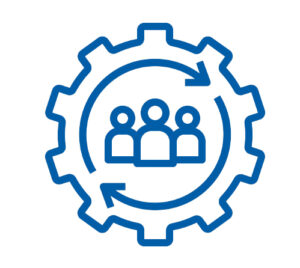When we started our first AI project with a large consumer goods manufacturer the welcome on the shopfloor wasn’t exactly warm. The staff feared that within a few weeks or months, a lot of them would lose their job. We realized quickly that the algorithms or data wouldn’t be the main challenge, AI change management would.
Five years on, nobody lost their job, and people appreciate the new, powerful tool that helps them be more efficient.
AI change management is not limited to staff’s fear of losing their jobs, there are other challenges you need to be aware of when implementing AI on your shop floor. In this blog we summarize the four main AI change management challenges and offer our insights and experience on how to address them.
 AI Change Management Challenge #1: Fear of job cuts
AI Change Management Challenge #1: Fear of job cuts
The fear that AI will replace humans and cause unemployment is real and, in many areas, we already see it happening. For example, ChatGPT writes decent code and text and is replacing junior computer scientists and content writers that aren’t highly specialized – and these are just two examples.
But what is that true for manufacturing?
No, not really. It is true that AI is exceptionally well suited to perform certain jobs in manufacturing such as quality control; AI can inspect products 24/7 with consistently high accuracy and never needs a break or calls in sick. For a job like this AI is clearly superior to humans and will replace them. However, based on our own experience, these often are jobs humans don’t want to do anyway. Many of our customers find it incredibly hard and sometimes impossible to hire personnel to perform quality control or other routine, monotonous tasks.
One of our customers has given up trying to hire people to monitor their line for contaminants that damage the equipment. Nobody was willing to do that job which requires standing all night looking at the line and trying to discern potential problems. They currently live with the fact that the line will go down occasionally and expensive repairs are needed.
AI is the perfect solution in a situation like this.
While this is just anecdotal evidence, there is data to back this up. A recent study by Deloitte predicts a shortage of more than two million American manufacturing workers by 2030.
These data indicate that manufacturing personnel don’t have to worry about losing their jobs, but the fear still remains, stoked by news reports that make blanket statements about AI as job killer.
To address these fears, we recommend starting the dialogue with the staff before the first models are implemented. Explaining what the new technology will do, how it will support them, rather than replace them, and how it will make their work easier or more efficient is critical to get buy-in. Offering training and opportunities to advance within the organization based on experience with AI implementation can also be a strong motivator.
 AI Change Management Challenge #2: Executive Alignment
AI Change Management Challenge #2: Executive Alignment
If you ask five executives within an organization what AI is and why they want to implement it you will get six different answers. Everybody has their own ideas what AI can and cannot do, why and where it should be implemented, whether or why it is needed at all, and what its price tag ought to be.
With no consensus on what problem AI is to solve and what the AI roadmap looks like for the mid- to long term, AI change management challenges are pretty much guaranteed. The best way to address this problem is by aligning expectations early on. This can be done in form of a workshop or as a series of conversations with individual executives and their staff to determine where realistic expectations can be set.
Another way to foster acceptance is by de-risking the decision to take the first step. A quick, affordable proof of concept study that demonstrates how AI can deliver value to the company goes long way to win over doubters and get the executive team aligned and thinking constructively about the future role of AI in the organization.
 AI Change Management Challenge #3: Educate the Relevant Departments
AI Change Management Challenge #3: Educate the Relevant Departments
AI implementation can touch different departments: quality, engineering, operations, and maintenance can all drive or be affected by an implementation. Take the example of implementing AI-driven predictive maintenance of a critical piece of equipment: operations might drive the initiative but maintenance holds important information in form of maintenance records. To get their collaboration, it is essential to bring maintenance along for the ride by explaining early on where and why their help is needed, and what AI can do for them.
In addition, it is crucial to think about what skills will be needed in the different departments, and what that means for hiring and upskilling initiatives. The practical challenges of implementing AI also need to be discussed between departments so that expectations are realistic.
Lastly, helping departments calculate the ROI of an AI project goes a long way towards getting buy-in and support.
AI Change Management Challenge #4: IT/OT Resistance
While an AI implementation might be driven by manufacturing, operations, engineering or maintenance, both IT and OT have to be on board as well. Our work has shown two main AI change management challenges associated with IT/OT:
![]() Most companies run on Microsoft and the IT personnel may not be familiar with Linux and Python. However, for AI, Linux is the only game in town and almost everything is done in Python. This is a fact of life and requires IT to learn new skills and adjust, however painful it may be. A very recent development that can help with that adjustment: large language models like ChatGPT are getting more sophisticated literally by the day. They are capable of writing ever more sophisticated code, e.g. in Python, based on prompts, or detailed instructions given to them in plain English. Having AI write the code needed to implement AI will ease this otherwise challenging transition.
Most companies run on Microsoft and the IT personnel may not be familiar with Linux and Python. However, for AI, Linux is the only game in town and almost everything is done in Python. This is a fact of life and requires IT to learn new skills and adjust, however painful it may be. A very recent development that can help with that adjustment: large language models like ChatGPT are getting more sophisticated literally by the day. They are capable of writing ever more sophisticated code, e.g. in Python, based on prompts, or detailed instructions given to them in plain English. Having AI write the code needed to implement AI will ease this otherwise challenging transition.
![]() The open source nature of AI is the other big headache for IT departments. All the AI packages – such as Tensorflow, Pytorch, sci-kit learn – are open source which is something many IT departments are adamantly opposed to. Their reasons are valid; cybersecurity is a huge issue and the thought of going to the internet and downloading a software package and regular updates instils justified dread in those tasked with keeping the company safe. However, there is no alternative if you want to implement AI and IT departments will have to overcome their strict policies and find a way to enable open source applications.
The open source nature of AI is the other big headache for IT departments. All the AI packages – such as Tensorflow, Pytorch, sci-kit learn – are open source which is something many IT departments are adamantly opposed to. Their reasons are valid; cybersecurity is a huge issue and the thought of going to the internet and downloading a software package and regular updates instils justified dread in those tasked with keeping the company safe. However, there is no alternative if you want to implement AI and IT departments will have to overcome their strict policies and find a way to enable open source applications.
Change management challenges are the most difficult ones to deal with: they are intractable, hard to predict and difficult to address. We have, for example, experienced passive resistance with giving us remote access to a company’s system that delayed a time-sensitive implementation by weeks, with little we could do about it other than escalating the issue and trying every workaround we could possibly think of.
In the end it comes down to proactively addressing potential issues with the implementation team and the relevant stakeholders, going into the process with a keen eye always looking out for potential AI change management issues that might be around the next corner and then addressing them with the same or greater urgency as technical challenges.

